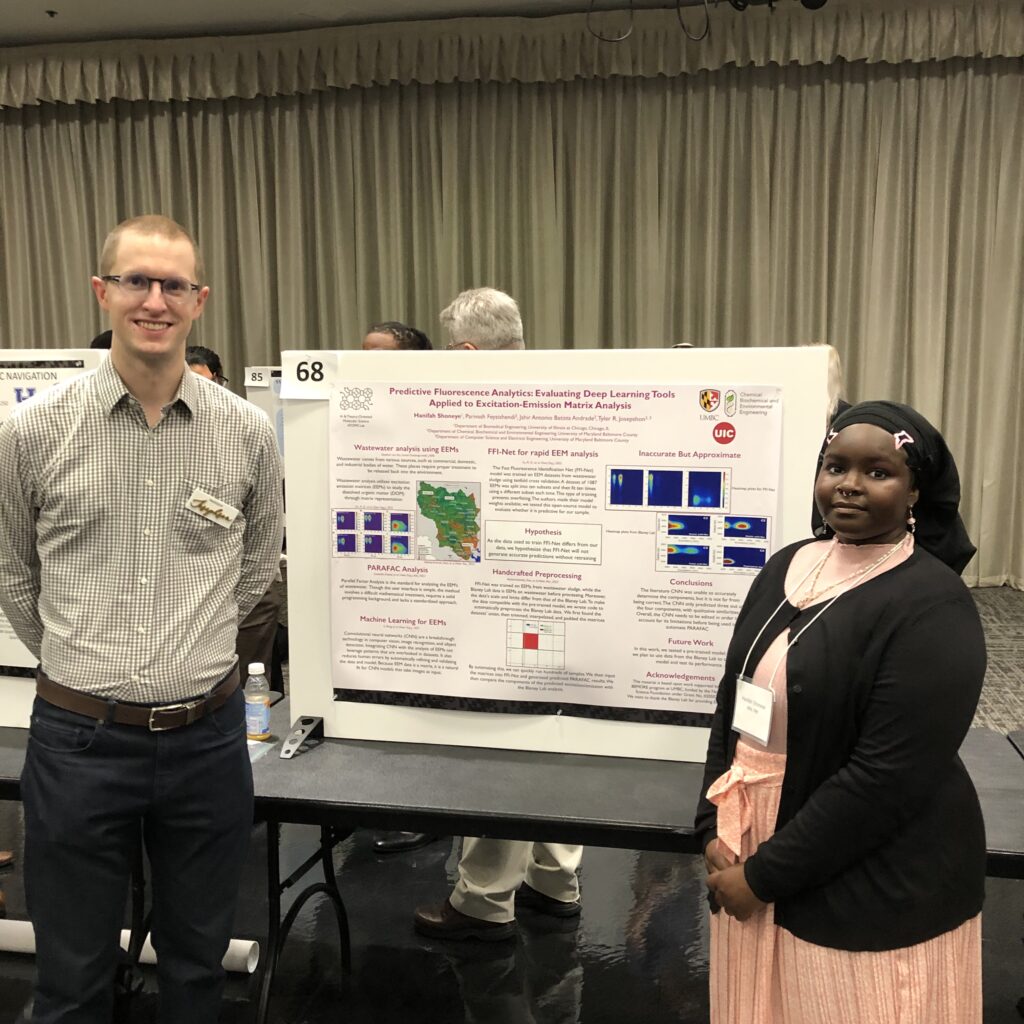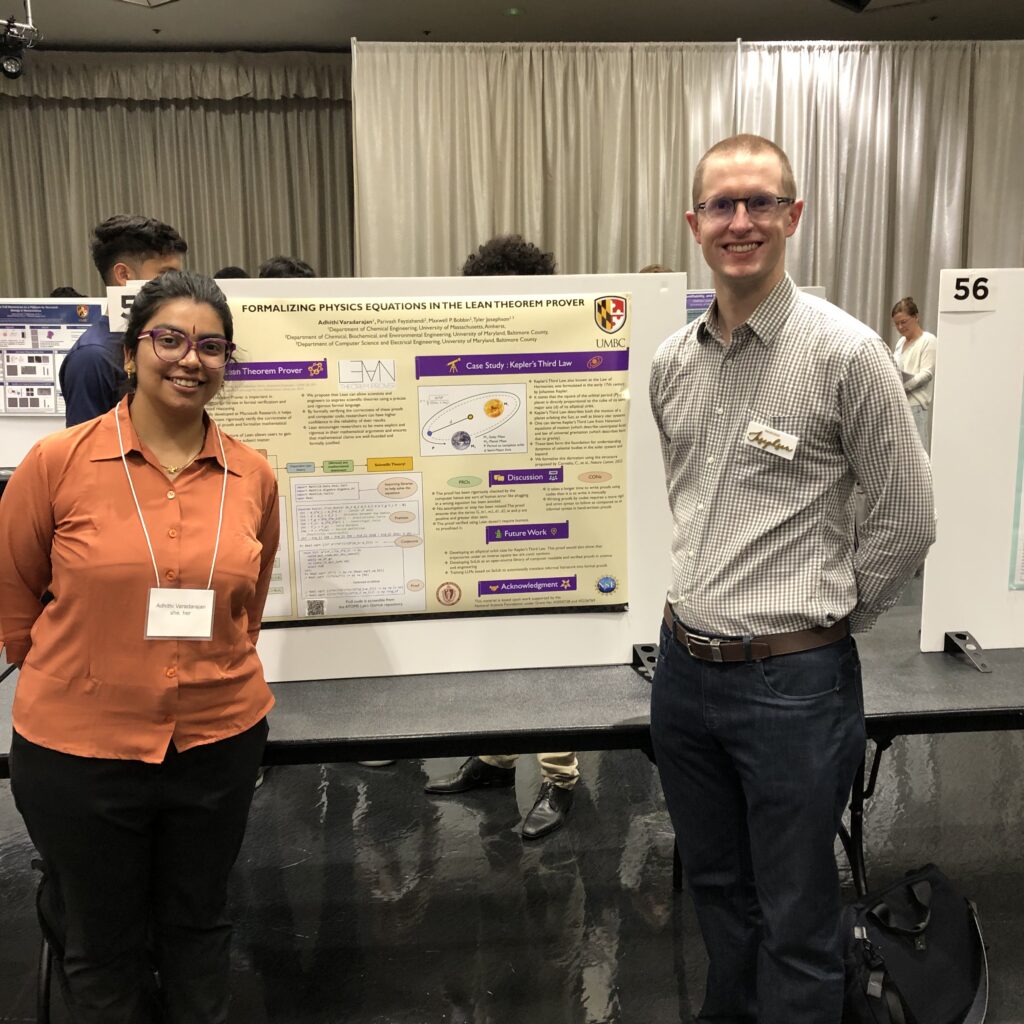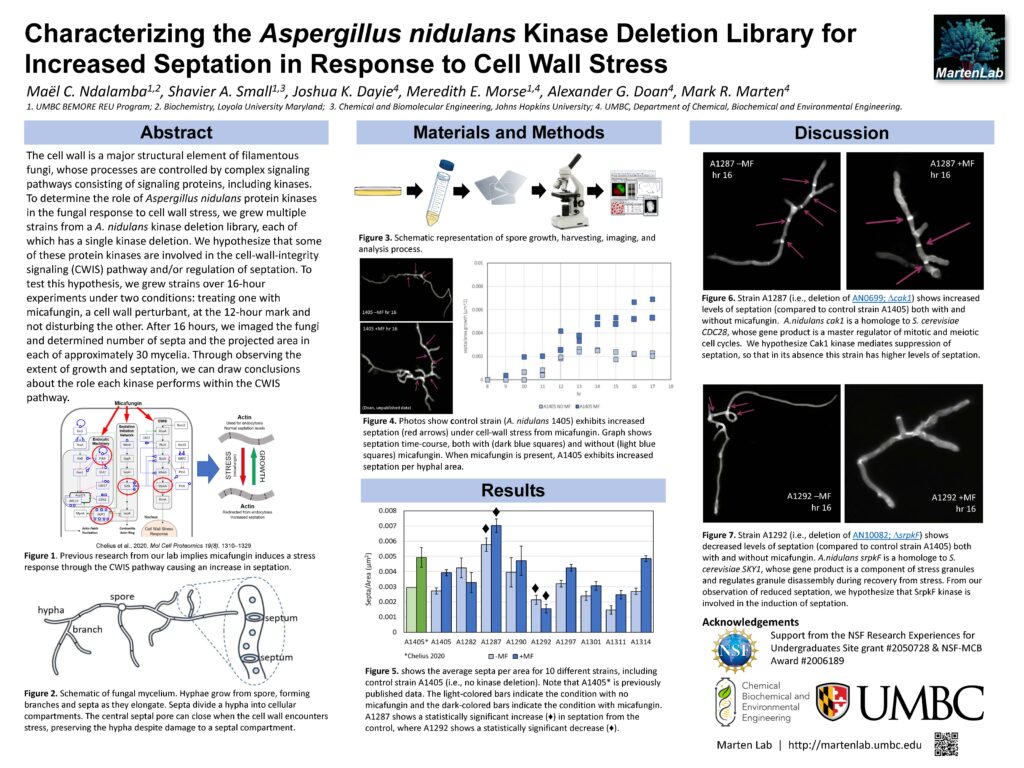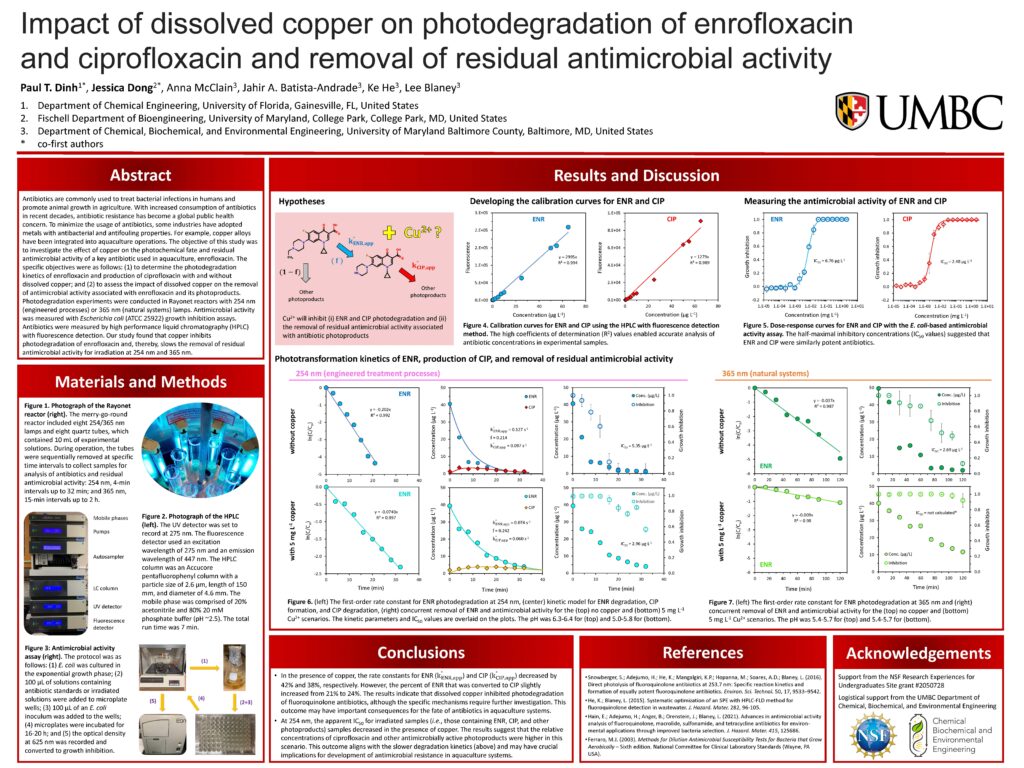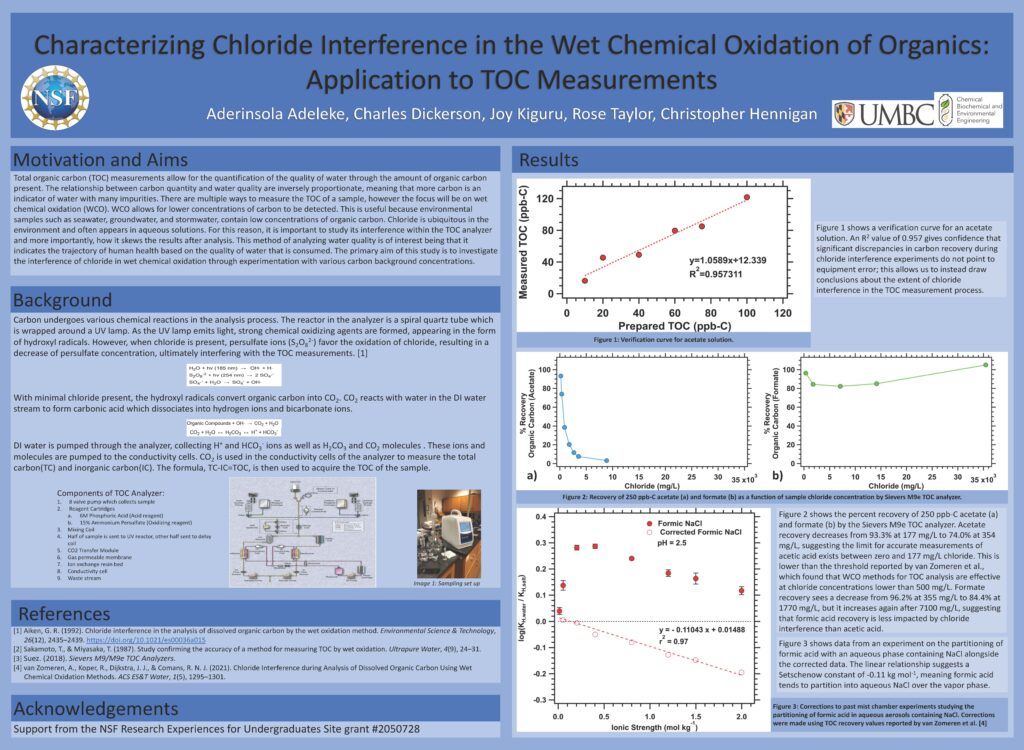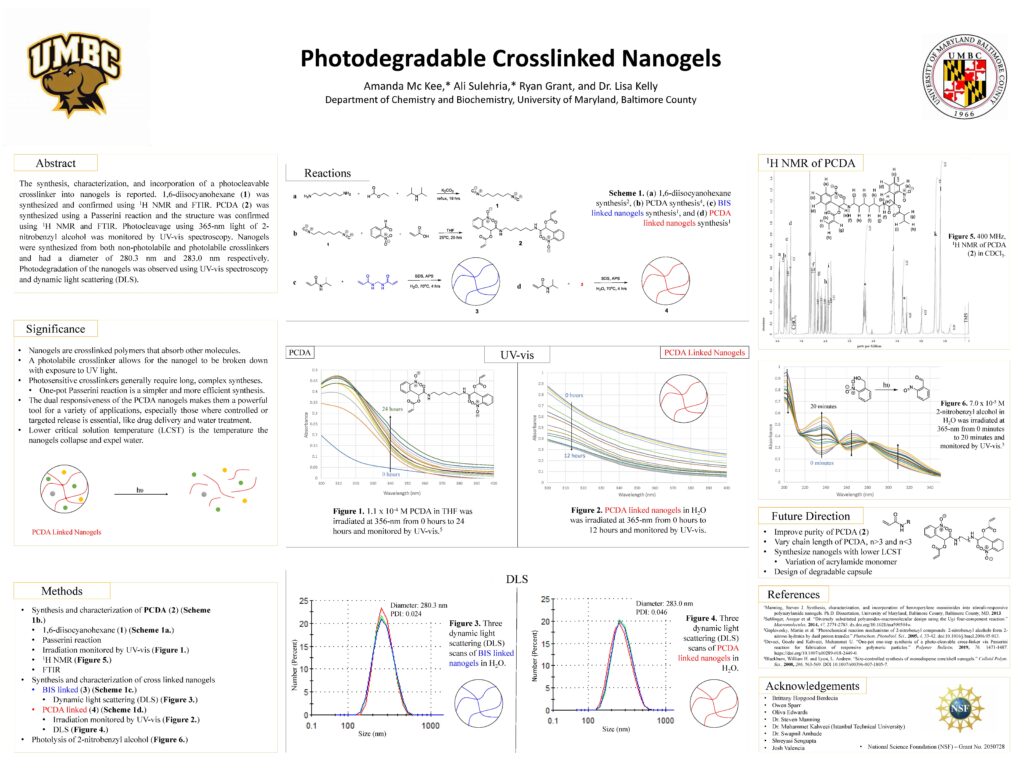2024
Research Projects addressed the following topics:
- water pollution & treatment
- sustainable plastic replacements
- smart polymers
- urban air quality
- novel biomaterials
- sustainable batteries and more
2023
BEMORE REU students presented their research at the Summer Undergraduate Research Fest (SURF) on August 9. 2023.
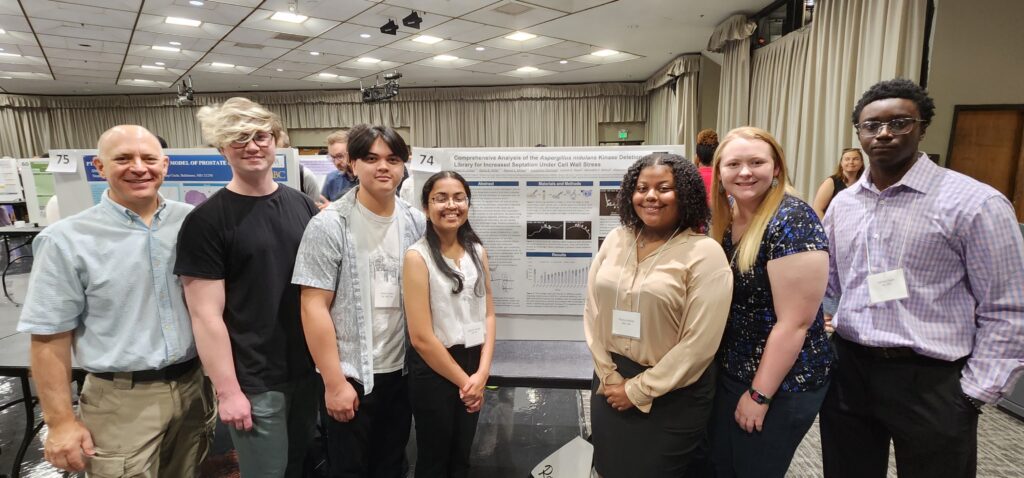
COMPREHENSIVE ANALYSIS OF THE ASPERGILLUS NIDULANS KINASE DELETION LIBRARY FOR INCREASED SEPTATION UNDER CELL WALL STRESS
Feonil G. Limiac12; Raina B. Miller13; Rianna S. Minter14; Greeshma Tarimala15; Joshua K. Dayie6; Meredith E. Morse6; Alexander G. Doan6; Mark R. Marten6
1UMBC BEMORE REU Program
2Towson University, Department of Molecular Biology, Biochemistry, and Bioinformatics (MBBB), TU, 8000 York Rd, Towson, MD 21252
3Southern Nazarene University, Department of Biology-Chemistry, SNU, 6729 NW 39th Expy, Bethany, OK 73008
4Delaware State University, Department of Biological Sciences, DSU, 1200 N Dupont Hwy, Dover, DE 19901
5Applications and Research Laboratory, Mount Hebron High School
6UMBC, Department of Chemical, Biochemical and Environmental Engineering
Filamentous fungi are both important human pathogens and are used prevalently in the bioprocess industry to produce valuable products. In both cases, the cell wall plays an important role. For example, in pathogens it can impact virulence and in bioprocessing productivity. To regulate their cell-wall structure, fungi rely on complex signaling pathways, composed of signaling proteins such as kinases. The objective in this study was to investigate the contribution of protein kinases from Aspergillus nidulans in the fungal response to cell-wall stress. By determining which protein kinases (in various signaling pathways) affect cell wall integrity and respond to cell wall stress, we will identify potential targets for new antifungal drugs. Previous research in our lab has shown (i) that cell-wall stress leads to increased levels of septation and (ii) that genetic mutations which reduce septation lead to more susceptible strains. We hypothesize that other, as yet unknown, kinases are involved in wall-stress-induced septation and survival. To test this hypothesis, we screened the A. nidulans kinase deletion library (98 strains), each lacking a specific kinase. We conducted experiments on each of the library strains under two conditions: one group was treated with micafungin, a cell-wall perturbant, at the 12-hour mark, while the other remained undisturbed. After 16 hours, we captured images of the fungi and measured the quantity of septa formed as well as the overall projected area (to measure growth). By assessing the extent of growth and septation, we are able infer the involvement of each kinase in responding to cell-wall stress.
Support for this research was provided by the National Science Foundation, through awards 2050728 and 2006189.
Predictive Fluorescence Analytics: Evaluating Deep Learning Tools Applied to Excitation-Emission Matrix Analysis
Hanifah Shoneye¹,² Parivash Feyzishendi ² Jahir Antonio Batista Andrade ² Tyler Josephson²
¹ Department of Biomedical Engineering, University of Illinois at Chicago, Chicago, IL, United States
² Department of Chemical, Biochemical and Environmental Engineering, University of Maryland, Baltimore County, UMBC, 1000 Hilltop Circle, Baltimore, MD 21250
The excitation emission matrix (EEM) is a spectroscopic technique used to analyze the fluorescence properties of a sample. The use of EEM helps monitor the quality of bodies of water, by measuring the presence of organic matter or pollutants in the water. The modern form of analyzing Excitation Emission matrix is Parallel Factor Analysis (PARAFAC). This method is time consuming; integrating machine learning in this process can be used to minimize error, and accelerate data analysis. Convolutional Neural Networks (CNN) are capable of identifying complex patterns in images and classifying them. CNN takes an image input and uses different layers to understand features and complex patterns. In this study, we investigate the applicability of a CNN model from the literature (Ren 2022)on our data, which spanned a different range of emissions and excitation wavelengths compared to that used in training and testing the literature model. To evaluate the model’s performance, we compared its analysis of our EEM data with our original PARAFAC analysis. The findings from this study shed light on the model’s suitability for inferring EEM components and its potential utility as a versatile analytical tool in diverse research and practical applications.
Support for this research was provided by the National Science Foundation (2050728).
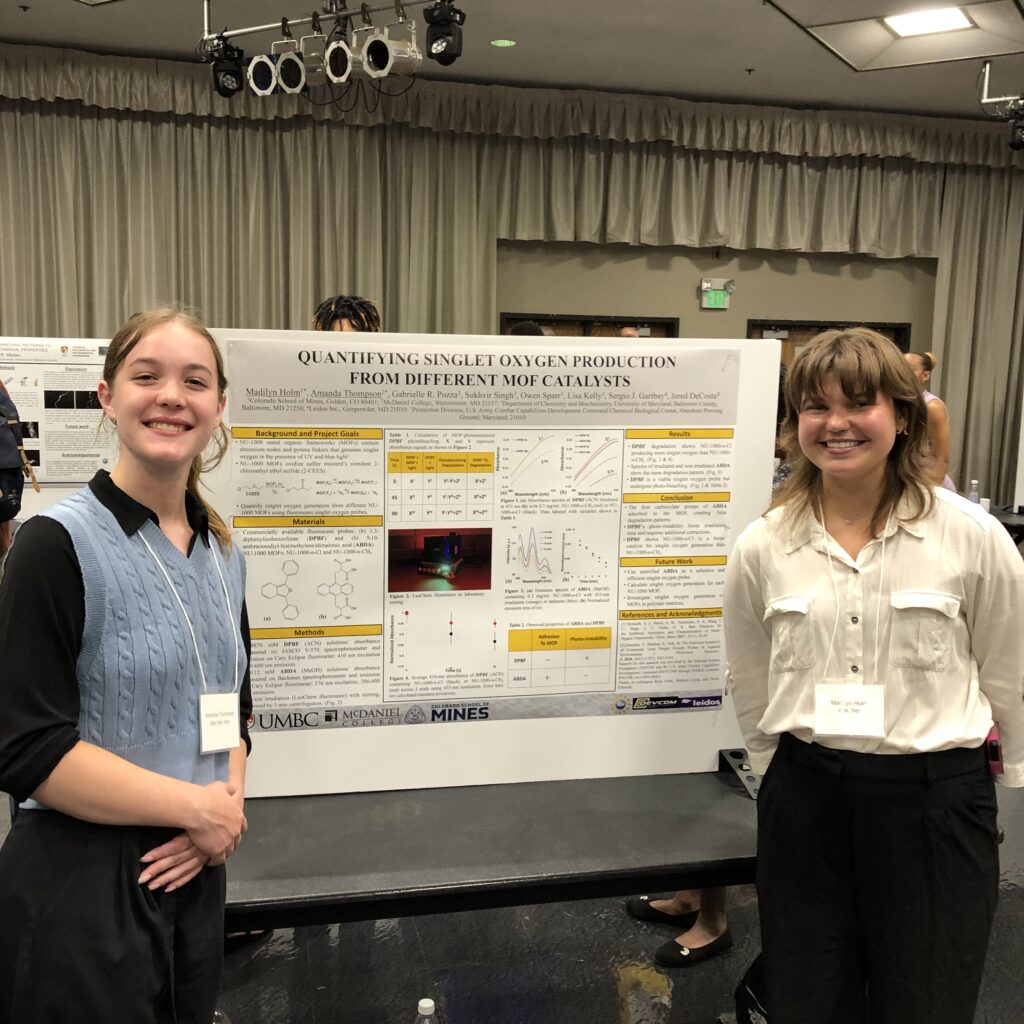
VISUALIZING SINGLET OXYGEN PRODUCTION OF DIFFERENT MOF CATALYSTS
Madilyn Holm1*, Amanda Thompson2*, Gabrielle R. Pozza3, Sukhvir Singh3, Owen Sparr3, Lisa Kelly3, Ann M. Kulisiewicz4, Sergio J. Garibay5, Mathew A. Browe4, Jared DeCoste4
1Colorado School of Mines, Golden, CO 80401
2McDaniel College, Westminster, MD 21157
3Department of Chemistry and Biochemistry, University of Maryland, Baltimore County, Baltimore, MD 21250
4Protection Division, U.S. Army Combat Capabilities Development Command Chemical Biological Center, Aberdeen Proving Ground, Maryland, 21010
5Leidos Inc., Gunpowder, MD 21010
Chemical warfare agents (CWAs) are extremely toxic weapons of mass destruction and are synthesized to incapacitate their targets. Among CWAs, sulfur mustard is a notorious nerve gas that is designed to burn skin and induce acute respiratory distress. Metal-organic frameworks (MOFs) are porous crystalline materials that have demonstrated promising results within CWA decontamination. NU-1000, a commonly used MOF containing zirconium nodes and functionalized tetra-(benzoic acid) pyrene linkers, has been shown to generate singlet oxygen in the presence of UV and blue light, which successfully oxidized sulfur mustard’s stimulant 2-chloroethyl ethyl sulfide (2-CEES). Our research aims to quantify singlet oxygen generation from different NU-1000 MOFs using fluorescent singlet oxygen probes, 1,3-diphenylisobenzofuran (DPBF) and 9,10-anthracenediyl-bis (methylene) dimalonic acid (ABDA). Through absorbance and fluorescence spectroscopies, changes in the singlet oxygen probe’s properties could be visualized and used to quantify the production of singlet oxygen that is photosensitized by the NU-1000 MOFs. Our research has identified the limitations of these probes for quantifying the photocatalytic production of singlet oxygen from the NU-1000s. DPBF is not photostable but was capable of detecting singlet oxygen with the inclusion of simultaneous control experiments. In the case of ABDA, the four carboxylate groups adsorbed to the MOF, creating false degradation patterns. As the result of this work, esterified ABDA derivatives are proposed as efficient and selective probes of singlet molecular oxygen produced upon irradiation of MOF materials.
Support for this research was provided by the National Science Foundation (2050728) and the U.S. Army Combat Capabilities Development Command (DEVCOM) through MSRDC (contract W911SR-14-2-0001-0045).
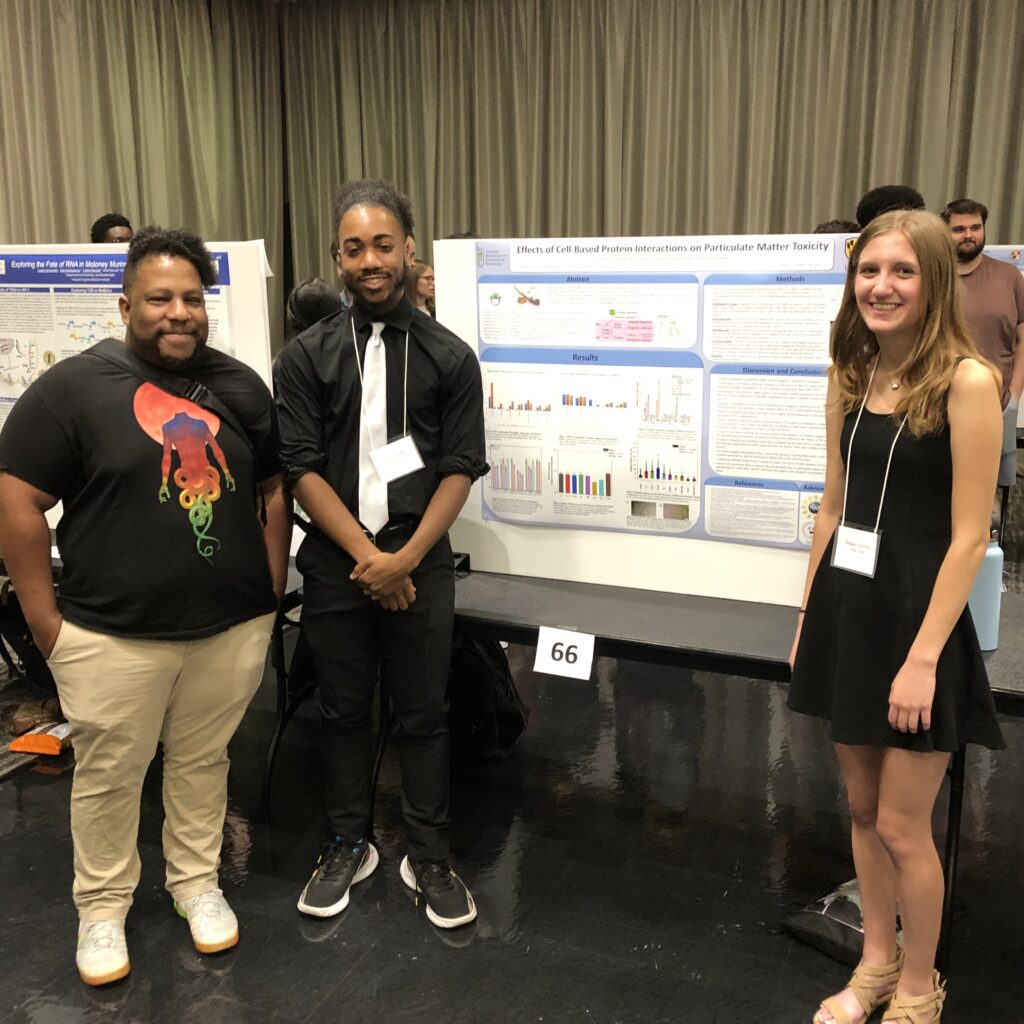
EFFECTS OF CELL-BASED PROTEIN INTERACTIONS ON PARTICULATE MATTER TOXICITY
Dylan Hayes1, Megan Harmon2, Joel Tyson3, Jayashree Yalamanchili, Ph.D.3, Chris Hennigan, Ph.D.3
1 Department of Chemistry and Biochemistry, Hampton University, 100 E Queen St, Hampton, VA 23669
2 Department of Chemistry, Illinois Institute of Technology, 10 W 35th St, Chicago, IL 60616
3 Department of Chemical, Biochemical, and Environmental Engineering, University of Maryland Baltimore County, 1000 Hilltop Circle, Baltimore, MD, 21250
Particulate matter (PM) are liquid or solid microscopic particles suspended in the air. PM forms as a result of natural occurrences, such as the wildfires of western Canada this summer, and anthropogenic sources such as industrial activity and diesel use. Fine particulate matter or PM 2.5, defined as particles having a diameter ≤ 2.5 µm, has been associated with various health effects and has been reported to have caused 4.2 million premature deaths in 2019 according to the WHO. However, little is known about the mechanisms through which PM is harmful to human health. Oxidative stress is considered one of the mechanisms of toxicity and occurs when the amount of reactive oxygen species (ROS) in the body exceeds the amount of antioxidants, causing damage to DNA, lipids, proteins, cells, and tissues. Oxidative Potential (OP), defined as the capability of particles to generate ROS, is considered a method to measure the potential of a particle to cause oxidative stress in the body. Though Oxidative Potential is commonly used as a standalone method of estimating oxidative stress, it fails to consider the role of direct protein interactions and therefore may not be an accurate measure of toxicity. In this study, we directly measured the effects of PM on key proteins as well as the effect of proteins on oxidative potential in acellular and cellular in vitro activity assays. Our results suggest that protein interactions with PM in cells may result in reactions of greater complexity that need to be accounted for when quantifying oxidative potential and PM toxicity. Further research needs to be done to elucidate these mechanisms.
Support for this research was provided by the National Science Foundation (2050728).
FORMALIZING PHYSICS EQUATIONS IN THE LEAN THEOREM PROVER
Adhithi Varadarajan1, Parivash Feyzishendi2, Maxwell P. Bobbin2, Tyler R. Josephson2
1Department of Chemical Engineering, University of Massachusetts, Amherst, 130 Natural Resources Road, Amherst, MA 01003
2 Department of Chemical, Biochemical, and Environmental Engineering, University of Maryland, Baltimore County, 1000 Hilltop Circle, Baltimore, MD 21250
Scientists and engineers write scientific computing software to solve problems, but sometimes these programs have bugs. Usual programming languages like Python, Java or MATLAB immediately detect syntax errors – errors like missing a semicolon or misspelling a keyword. However, these programming languages don’t detect semantic errors – such as using an incorrect form of an equation in a function. To help the scientific community achieve bug free codes, we are exploring a programming language called Lean Theorem Prover, which has been developed by mathematicians for theorem proving. Lean allows users to state math theorems in code and write proofs about them, automatically checking whether the proofs are correct. By writing scientific equations in Lean, we can use Lean to detect both semantic and syntax errors, ensuring the code is correct. In this way, Lean can ensure the correctness of the codes in a way that other programming languages cannot. To illustrate this new approach to writing code in scientific computing, we consider Kepler’s Third Law. Using theorems and tactics from mathlib, Lean’s math library, we show how Kepler’s Third Law is related to various equations of motion in physics. Formalizing theorems in Lean helps to verify the theorems previously written and also develop new theorems.
Support for this research was provided by the National Science Foundation (2050728 and 2236769).

Impacts of pH and salt concentration on uptake of per- and polyfluoroalkyl substances (PFAS) by anion-exchange membranes
Sydney Braithwaite1, Nick Berry2, Ke He2, Margaret Siao2, Jiabao Liang2, Yoonjin Cho2, Lee Blaney2
1Towson University, 8000 York Road, Towson, MD 21252
2University of Maryland Baltimore County, 1000 Hilltop Circle, Baltimore, MD 21250
Per- and polyfluoroalkyl substances (PFAS) are contaminants of emerging concern that are present in water resources around the country. The Environmental Protection Agency recently proposed strict regulations to protect Americans from PFAS-contaminated drinking water. Due to temporal variation in PFAS concentrations, grab samples are not representative of average PFAS levels in surface water. To address this challenge, we developed a prototype Passive Sampler comprised of an anion-exchange membrane. The goal is to enable PFAS adsorption to the membrane, and then use equilibrium relationships to back-calculate the time-averaged concentrations of 19 PFAS in a water source. We were particularly interested in examining whether the solution pH and salt content would affect PFAS uptake. These research questions were addressed by calculating the selectivity coefficients of 19 PFAS against chloride, a common background ion in water; note, the selectivity coefficients are the equilibrium constants for the ion-exchange reaction. In general, the selectivity coefficients demonstrated a clear trend with chain length, with long-chain PFAS being preferentially adsorbed by the membrane due to electrostatic interactions (PFAS head) and hydrophobic interactions (PFAS tail); for similar reasons, the long-chain PFAS also demonstrated greater adsorption to the containers. We hypothesized that the selectivity coefficients for PFAS that primarily exist as anions would not be sensitive to solution pH. PFOSA was the only compound that exhibited different selectivity coefficients when the pH was increased from 5.0 to 9.0. This outcome was attributed to the acid dissociation constant of PFOSA (pKa = 6.24), which caused a fraction of PFOSA to be neutral at lower pH and therefore not available to interact with the anion-exchange membrane. We hypothesized that the higher salt concentrations would cause salting-out phenomena that increase the selectivity coefficients for PFAS over chloride. The results confirmed this hypothesis. These findings will allow us to develop a universal calibration of the anion-exchange membrane-based passive sampler for use in different water quality conditions. Ultimately, our goal is to deploy the passive sampler to ensure accurate and time-averaged concentrations of PFAS in drinking water supplies to protect public health.
Support for this research was provided by the National Science Foundation (2050728).
2022
(click the poster to open a larger version, click the title to download a pdf)
Characterizing the Aspergillus nidulans kinase deletion library for increased septation in response to cell-wall stress
by Mael Ndalamba*, Shavier Small*, Meredith Morse, Joshua Dayie, Alex Doan, Dr. Mark Marten
Impact of dissolved copper on photodegradation of enrofloxacin and ciprofloxacin and removal of residual antimicrobial activity
by Paul Trong Dinh*, Jessica Dong*, Anna McClain, Jahir Antonio Batista Andrade, Dr. Ke He, Dr. Lee Blaney
Characterizing chloride interference in the wet chemical oxidation of organics: Application to TOC measurements
by Aderinsola Adeleke*, Charles Dickerson*, Joy Kiguru, Rose Taylor, Dr. Christopher Hennigan
Photodegradable crosslinked nanogels
by Amanda McKee*, Ali Sulehria*, Ryan Grant, Dr. Lisa Kelly
